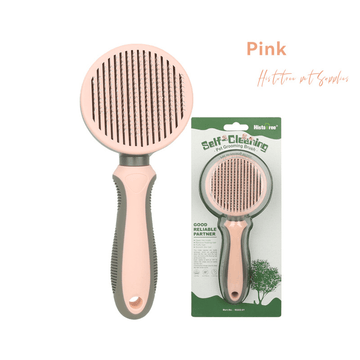Deshedding brushes are a vital tool for dog owners who want to keep their furry friends looking and feeling their best. Not only do they help to remove loose hair and prevent matting, but they also promote healthy skin and fur by distributing natural oils. In this comprehensive guide, we will discuss everything you need to know about deshedding brushes, including how to choose the right one for your dog, how to use it effectively, and how to maintain it for long-lasting performance.
Understanding the Benefits of Deshedding Brushes for Dogs
Deshedding brushes are designed to effectively remove loose hair, dirt, and debris from your dog's fur, leaving it looking clean and healthy. Here are just a few of the many benefits that come with using a deshedding brush:
-
Prevent matting and tangles: When a dog's fur becomes matted or tangled, it can be painful and uncomfortable for the animal. Deshedding brushes help to prevent this by removing loose hair and promoting healthy fur growth.
-
Reduce shedding: Shedding is a natural part of a dog's life cycle, but it can be frustrating for owners who find hair all over their furniture and clothing. Deshedding brushes help to reduce shedding by removing loose hair before it falls out on its own.
-
Improve skin and fur health: Deshedding brushes distribute natural oils throughout your dog's fur, promoting healthy skin and fur growth. This can help to prevent skin irritations and promote a shiny, healthy coat.
-
Bond with your dog: Brushing your dog is a great way to bond with them and show them affection. Deshedding brushes can be especially helpful for dogs who are nervous or anxious, as the gentle brushing motion can help to soothe and calm them.
Choosing the Right Deshedding Brush for Your Dog
There are many different types of deshedding brushes on the market, each designed for different types of fur and different breeds of dogs. Here are a few things to consider when choosing the right deshedding brush for your dog:
-
Fur type: Consider your dog's fur type when choosing a deshedding brush. For example, breeds with long, silky fur will require a brush with long, gentle bristles, while breeds with short, thick fur will require a brush with shorter, stiffer bristles.
-
Size of your dog: The size of your dog will also play a role in choosing the right deshedding brush. A small brush may not be effective for a large dog, while a large brush may be too bulky for a small dog.
-
Ease of use: Consider how easy the brush is to use. Some brushes come with long handles for easier reaching, while others are compact and easy to store.
-
Price: Deshedding brushes can range in price from a few dollars to hundreds of dollars, so it's important to choose one that fits your budget. Keep in mind that a higher price does not always equal a better quality brush.
How to Use a Deshedding Brush Effectively
Once you have chosen the right deshedding brush for your dog, it's time to start using it. Here are a few tips for using a deshedding brush effectively:
-
Start slowly: Begin by gently brushing your dog's fur for a few minutes at a time, gradually increasing the time as your dog becomes more comfortable with the brushing process.
-
Brush in the direction of fur growth: Always brush in the direction of fur growth to avoid pulling or damaging your dog's skin. Start at the head and work your way down, brushing each section thoroughly before moving on to the next.
-
-
Be gentle: Deshedding brushes are designed to remove loose hair, not to yank or pull at it. Always use gentle, circular motions when brushing your dog, and be mindful of any areas that may be sensitive or prone to matting.
-
Remove hair as you go: As you brush your dog, use a comb or your fingers to remove any loose hair that has been gathered by the brush. This will make the brushing process more efficient and prevent the brush from becoming clogged.
-
Brush regularly: For best results, make deshedding brushing a regular part of your dog's grooming routine. The frequency will depend on your dog's breed, fur type, and lifestyle, but most dogs should be brushed at least once a week.
-
Maintaining Your Deshedding Brush for Long-lasting Performance
To ensure that your deshedding brush performs at its best for as long as possible, it's important to keep it clean and well-maintained. Here are a few tips for maintaining your deshedding brush:
-
Clean after each use: After each use, remove any loose hair from the brush and clean it with soap and water. Rinse thoroughly and allow the brush to air-dry completely before storing it.
-
Store in a dry place: To prevent mold and mildew growth, store your deshedding brush in a dry place. Avoid storing it in damp areas, such as a bathroom or basement.
-
Replace when necessary: Over time, the bristles of your deshedding brush may become worn or frayed, affecting its performance. If this happens, it's time to replace the brush.
Conclusion
Deshedding brushes are an essential tool for any dog owner who wants to keep their furry friend looking and feeling their best. By choosing the right brush, using it effectively, and maintaining it properly, you can enjoy all the benefits that come with having a healthy, well-groomed dog.
FAQs
-
How often should I brush my dog with a deshedding brush? The frequency of brushing will depend on your dog's breed, fur type, and lifestyle, but most dogs should be brushed at least once a week.
-
Can a deshedding brush be used on all breeds of dogs? Yes, deshedding brushes can be used on all breeds of dogs, but it's important to choose the right brush for your dog's fur type and size.
-
How do I know if my dog's fur is matted or tangled? Matted or tangled fur will feel thick or bumpy to the touch, and may be difficult to comb or brush through.
-
Can a deshedding brush help with shedding? Yes, deshedding brushes help to reduce shedding by removing loose hair before it falls out on its own.
-
How do I clean my deshedding brush? To clean your deshedding brush, remove any loose hair, and clean it with soap and water. Rinse thoroughly and allow it to air-dry completely before storing it.





